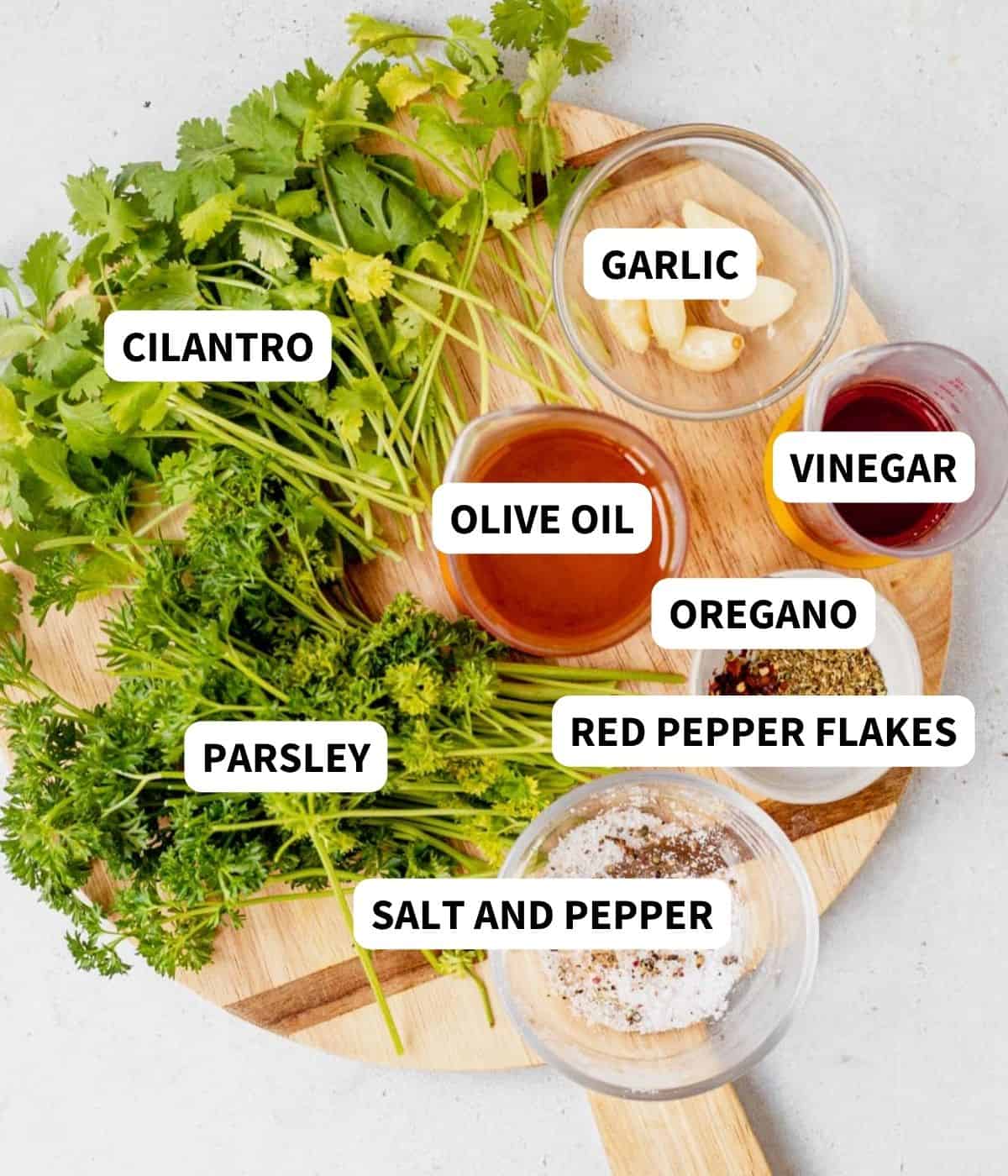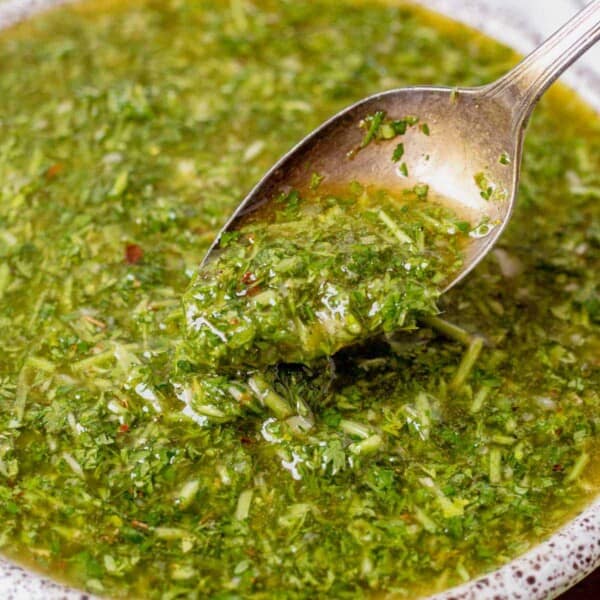This cilantro chimichurri is the cilantro version of an authentic chimichurri recipe. It’s a simple sauce that’s made from just a handful of ingredients, yet packed with so much flavor and fresh herbs.
One of our favorite ways to dress up a delicious piece of steak (or any meat) is with chimichurri sauce.

Aside from using the best chimichurri sauce, we’ve done a lot of research on how to properly prepare a steak. Take a look through our guide to different cuts of beef first, to decide which steak is best for you.
Our go-to is flank steak, and we’ve got a guide to grilling flank steak as well as cutting it. But if flank steak isn’t your thing, we have some suggestions for the best substitutes.
Regardless of which cut of meat you choose, you’ve got to give this homemade steak seasoning a try.
Why this Cilantro Chimichurri Sauce Recipe Works
- Packed with fresh ingredients: One of the best parts of this chimichurri is how incredibly fresh it tastes.
- Easy recipe: If making homemade chimichurri sauce seems intimidating to you, this simple recipe will prove you wrong.
- Adds color: The green herbs not only give the chimichurri the best flavor, but the vibrant green color it’s known for. The green sauce is the perfect way to add flavor and color to your meat dishes.
- Brings depth: This flavorful chimichurri sauce gives your grilled steak a punch of flavor.
What is Chimichurri?
Chimichurri is a flavorful and vibrant sauce or condiment that originated in Argentina and is widely enjoyed in cuisines across South America.
A traditional chimichurri sauce, (or an authentic Argentinian chimichurri), is made with flat leaf parsley as the main ingredient. However, there are different ways to prepare this versatile sauce — like with cilantro.
Overall, it’s known for its vibrant green color and its bold, tangy, and herbaceous flavors. It adds a fresh and zesty kick to grilled meats and is commonly served at room temperature.
The Argentinian sauce can also be used as a marinade, a sauce for roasted vegetables, salad dressing, or dipping sauce for bread.
Grab These Ingredients
Here are the simple ingredients for this cilantro chimichurri. They’re easy and affordable to find in grocery stores (or your herb garden). Jump down to the recipe card for exact measurements.

- Olive oil: A good quality extra virgin olive oil adds richness and a smooth base. Avocado oil is a good substitute.
- Red wine vinegar: The tangy vinegar adds an acidic profile to this already flavorful sauce. It’s a nice contrast to the flavor of the herbs and enhances the flavors of the grilled meats. Substitute with white wine vinegar if needed.
- Parsley: Chimichurri typically calls for flat-leaf parsley, also known as Italian parsley, due to its robust flavor. It uses both the stems and the leaves.
- Cilantro: The key ingredient to this twist on a classic chimichurri. Again, you want to use both the stems and the leaves. If you have extra, here’s how to keep cilantro fresh.
- Garlic: Use fresh garlic for the best garlic taste.
- Red chili: Deseed and chop up the red chilis. You can substitute with 1/2 tsp red pepper flakes.
- Dried oregano: You can adjust the amount of dried oregano to your tastes. If using fresh oregano, you’ll want to triple the amount.
- Coarse salt: Like a sea salt, kosher salt, or pink Himalayan salt.
- Cracked black pepper: adds a hint of spice and a subtle heat.
Recipe Variations
There are so many delicious chimichurri recipes out there. One of the best things about this classic sauce is finding out what makes a good chimichurri in your own book. Feel free to get creative and experiment with chimichurri in various dishes. Here are just a few ideas for recipe variations:
- Add citrus like lemon juice or lime juice to make the flavor even brighter.
- Mix in diced red onion for a little extra crunch.
- Swap out the cilantro for fresh mint to make a mint chimichurri.
- Add an extra garlic clove. The amount of garlic used can vary depending on personal preference and the desired level of garlic intensity.
How to Make Cilantro Chimichurri
The full printable recipe is below, but let’s walk through the steps with some photos and a video so you have a clear idea of what to expect. This cilantro chimichurri is really easy and these step-by-step instructions will make sure it turns out every time.
Video: Watch How to Make It
Add Ingredients to a food processor: Measure out the ingredients and add theem to the bowl of a food processor or high-speed blender.
Pro Tip: you can use the leaves and stems of the cilantro.

Blend: Pulse for 1-2 seconds 4-5 times. It shouldn’t be completely combined like a pesto. It’s a loose, oil-based sauce so it should have a looser texture. If you don’t have a food processor, you can finely chop/mince all of the ingredients. Stir them together in a small bowl with a spoon.

Serve: enjoy immediately or store in an airtight container in a sealed jar in the fridge for up to 1 week. Use it to marinate chicken and steak, baste meat on the grill, or finish cooked meat before serving.
Pro tip: For the best results, chimichurri should be served at room temperature. Allowing it to sit at room temperature before serving enhances its flavors and aromas. It allows the herbs, spices, and the rest of the ingredients to infuse together.

Recipe FAQs
Chimichurri has a fresh, herbaceous, and tangy taste with a balance of flavors. It has a mild spiciness and garlic definitely plays a role in the flavor profile. Overall, it provides a refreshing and flavorful accompaniment to grilled meats and other dishes.
If you find that a particular chimichurri recipe tastes too vinegary for your liking, you can adjust the amount of vinegar used or try a different recipe that balances the flavors to your preference. Chimichurri should have a well-rounded taste, with the vinegar playing a supporting role rather than being the dominant flavor.
What to Serve with Cilantro Chimichurri
Chimichurri is the perfect condiment for grilled meats like grilled ribeye or this grilled burger. Add it to a flank steak like this mushroom and spinach stuffed flank or any of these substitutes for flank steak.
It also can be a great sauce for flavoring veggies these garlic roasted mini peppers. Substituting the salad dressing in a recipe like this grilled zucchini salad is a great way to use up leftover chimichurri.
Some side dishes to go along with your meat and cilantro chimichurri dishes include these dairy-free mashed potatoes, easy sweet potato salad, or crispy balsamic brussel sprouts.
Freezing and Storing Tips
It’s best to use chimichurri within a few days of preparing it. While it’s safe to eat for longer, the flavors and freshness of the chopped herbs may start to diminish.
If you have a large batch of chimichurri that you won’t consume within a few days, you can freeze it for longer storage. Transfer the sauce to a freezer-safe container or an ice cube tray, leaving some space for expansion. Seal the container tightly and freeze for up to 3 months.
When ready to use, thaw it in the refrigerator overnight and give it a stir before serving.

If you make this recipe, I’d love for you to give it a star rating ★ below. You can also tag me on Instagram so I can see it!
More Cilantro Recipes
Good news, cilantro lovers: we have you covered with more of our favorite cilantro recipes.
Cilantro Chimichurri
Save this Recipe!
Ingredients
- 3/4 cup extra virgin olive oil
- 3 tablespoons red wine vinegar
- 3/4 cup fresh parsley stems and leaves
- 3/4 cup fresh cilantro stems and leaves
- 4 cloves garlic
- 1 small red chili deseeded and chopped (or 1/2 tsp red pepper flakes) (Note 1)
- 1 1/2 teaspoons dried oregano
- 1 teaspoon coarse salt
- 1/2 teaspoon fresh cracked black pepper
Instructions
- Add all of the ingredients to a food processor. Pulse for 1-2 seconds 4-5 times or until the leaves and stems are in small pieces. it shouldn’t be completely combined like a pesto. It’s a loose, oil-based sauce so it should have a looser texture. Alternately, finely chop/mince all of the ingredients and stir them together with a spoon.
- Serve immediately or store in an airtight container in the fridge for up to 1 week. Use it to marinate chicken and steak, baste meat on the grill, or finish cooked meat before serving.
Notes
Video
Equipment
- Food processor or high-speed blender
Nutrition
Nutrition information is automatically calculated, so should only be used as an approximation.
This post may contain affiliate links. Read our disclosure policy.










